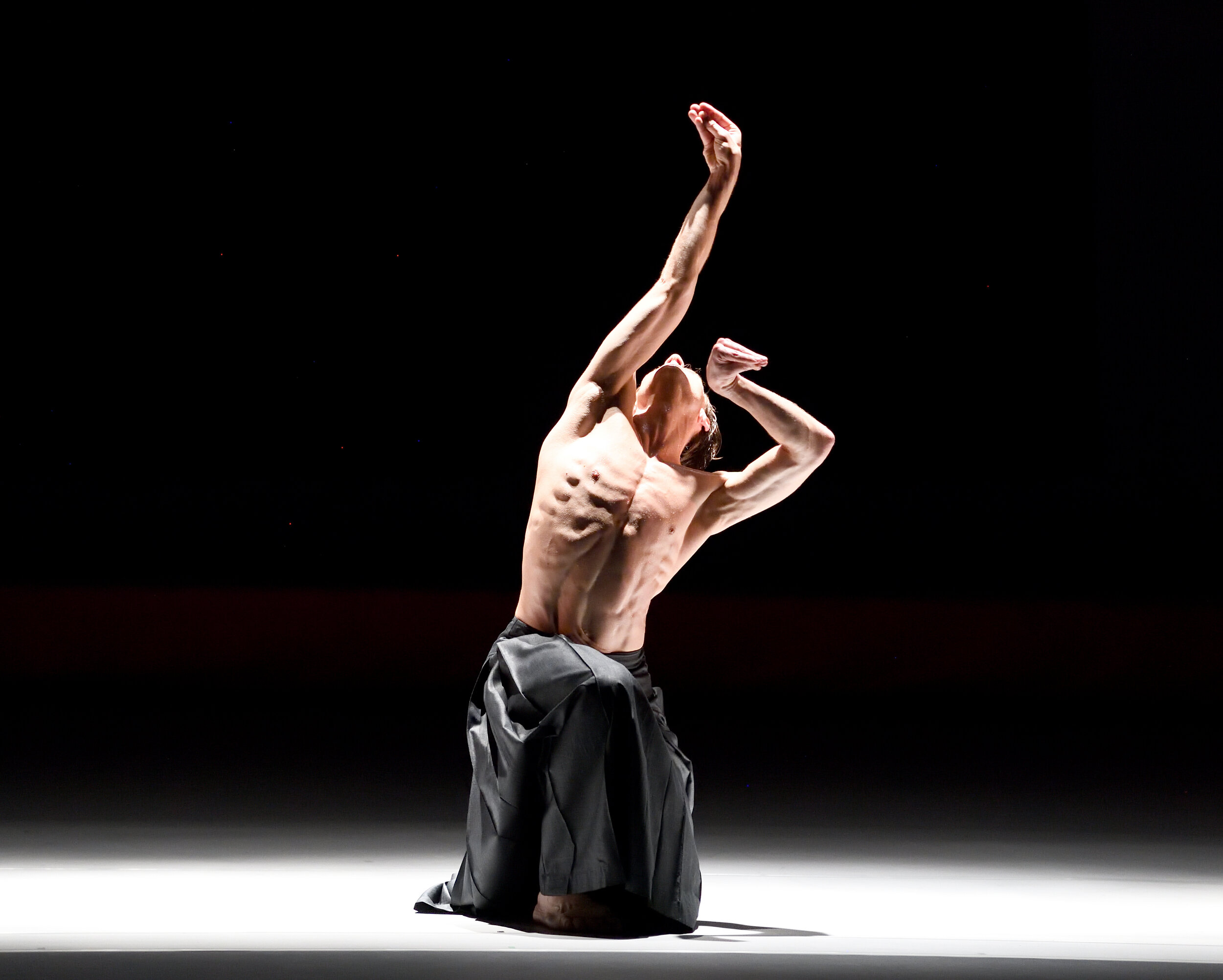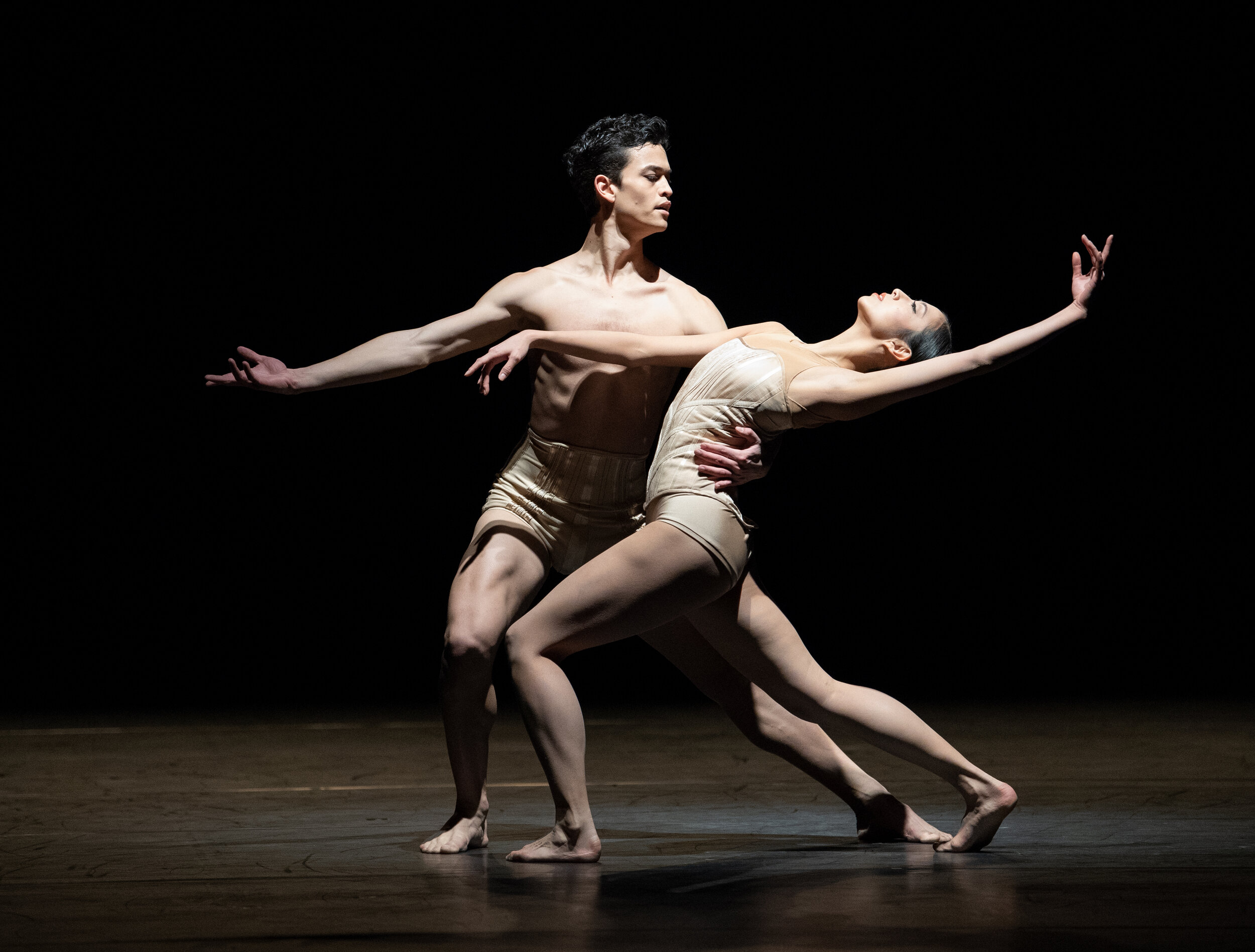
50/50
THE DIFFERENCE BETWEEN ARTS FUNDING IN
America VS Germany
Vivien Arnold | Director Communications and Dramaturgy, The Stuttgart Ballet x
Ellen Walker | Executive Director, Pacific Northwest Ballet
The Stuttgart Ballet in Louis Stiens’ Messenger, © Stuttgart Ballet
VIVIEN ARNOLD I worked for Houston Ballet for six years from 1988 to 1994. Admittedly I have been in Germany now for over 25 years, but I can’t imagine that the struggle for survival for arts organisations in the US has gotten any easier. In comparison, the situation we have here in Germany is paradise in terms of subsidy and funding. It’s a diametrically opposed system to what I experienced in Houston. I assume your situation is similar to that of the Houston Ballet.
ELLEN WALKER Yes; government funding is less than 1% of our overall budget.
VIVIEN ARNOLD From a European perspective that is unthinkable - just crazy.
ELLEN WALKER The comparison is dramatic. In advocating for our sector during the pandemic we’ve made the case over and over again about the existential crisis the performing arts sector was facing as a result of the pandemic, and that the sector has suffered from lack of investment for decades.

VIVIEN ARNOLD Having worked in Houston (and years before that as a dancer for the now-defunct Hartford Ballet) and looking back on it, I would like to say this: that despite not having great federal, state, or municipal funding, amazing art and dance is made in the US! Our theater (State Theater Stuttgart, home to the Stuttgart Ballet) is subsidized up to 70% by the state of Baden-Württemberg and the city of Stuttgart. It is an ideal system for creating art. So that’s what I mean with diametrically opposed. It never ceases to amaze me how much the government here invests in the arts. I will say, however, that I think things might change over the next 20 years. Discussions are slowly starting here about who we are making the art for. Who actually attends the concerts, operas, plays, and ballets? Who visits the museums? All citizens are paying for the arts with their taxes but who’s actually benefiting from that? Because in the end, despite the funding, the tickets are still quite expensive. The best seats in our house sell for up to 120 Euro (for ballet) even though each seat is, in essence, subsidized.



Friedemann Vogel in Akram Khaan’s Kaash, © Stuttgart Ballet
Jason Reilly in Maurice Béjart’s Bolero, © Stuttgart Ballet
Mackenzie Brown and Henrik Erikson in Marco Goecke’s Nachtmerrie, © Stuttgart Ballet
ELLEN WALKER I mean that also speaks to the incredible quality of work that you do. You can do that because you have that buffer of support.
VIVIEN ARNOLD Very few German citizens would think to question the public benefit of the arts! The Germans prize culture, so for them, this theater is a very important part of daily life. Stuttgart is the home of Porsche and Mercedes Benz. So you have that Mercedes Benz symbol, and another symbol for the city is the Stuttgart Ballet. So they’re just as proud of their ballet company as they are of their automobile industry. Also because we tour a lot internationally, and when we tour we take the name of the city with us. So they have a strong sense that we belong to the city and also the state of Baden-Württemberg. So we do not (yet) have the necessity to justify our existence. But the question has come up of how to encourage people who do not yet attend the arts to do so.
ELLEN WALKER That’s so interesting. There’s a couple of good resources that we rely on here– Donna Walker-Kuhne, I don’t know if you’ve seen her work on audience development, and it’s very much about who’s invited, who’s not invited, and it’s about getting us to think about lowering barriers of participation. And then we use this reference a lot, it’s called the Road to Results and PNB is featured in this. You can download it from the Wallace Foundation website. It gives you these nine effective practices of audience development and it helps you identify the problems and sort of set up a research frame of mind so that you can understand people’s barriers to participation and how to lower those.
One thing that’s nice about this is that it shows funders that you’re undertaking an effort to widen the aperture of that invitation. For us, our audience was aging like every classical arts audience, and so we thought we better take action and invest resources to broaden the audience. Since Peter Boal’s artistic vision is animated by contemporary work, we thought there would be an inherent appeal for young people. But it’s so interesting, the people who love contemporary work the most are older established patrons.
We launched this program where we went straight to employees to try to engage them since investing in arts and culture may not be a message they get from leadership. That may have changed; it’s hard to know right now. I will say, Microsoft is wonderful about supporting arts and culture, and that’s been true for a very long time. Another funder said that tech companies are organized around problem-solving, and they don’t see arts support as solving a problem. I don’t know if that’s all the way true, but since we haven’t performed for audiences in person since March of 2020, we have plenty of problems.

VIVIEN ARNOLD Artists are the ones addressing the problems, pointing them out, and making them visible to society in creative ways. We are very lucky because we do also have a main corporate sponsor and that is Porsche. They approached us, we didn’t approach them. They came to us and said, “we are wanting to do more for the community that we’re based in, so we reviewed all the cultural institutions in Stuttgart and we think you’re the fit. So what do you think?” And I was thinking: if this were the US, nobody would believe me that they called us.
ELLEN WALKER You have powerful corporate support and government support for arts and culture, which we don’t really have— we have the National Endowment for the Arts, but we don’t have a cabinet-level person who represents this sector. Do you have individual donors?
VIVIEN ARNOLD Everything in Germany involving the arts happens on the state and municipal level, not on the federal. So the State of Baden-Württemberg has a cultural minister but not the federal government. And in terms of individual donors? Almost non-existent. Because every German citizen pays his taxes, and those taxes - in part - subsidize the arts. So the average German says to himself: I pay for that theater, opera, and ballet company with my taxes, why would I donate on top? And what’s crucial is that one gets almost no tax break here for donating. In the US you get a considerable tax break, but here you don’t. So it’s not necessarily in the interest of the individual to donate. Unless it’s for a really important cause. We just built a new school and the fight for this new building took 25 years. The building cost $50 million, and the city and the state had to pay for it 50/50. The city wasn’t committing to the project, so a group of citizens got together and said: “This is important, we’re going to put down some seed money and show the city that the people of Stuttgart support this project and that they also have to do their part.” So sometimes you will get that kind of civic engagement. But we have very few individual donors.

Agnes Su and Adhonay Soares da Silva in Jiri Kylian’s Petite Mort. © Stuttgart Ballet
VIVIEN ARNOLD I would point to the Reagan era. It's no coincidence that he and Thatcher were in office at the same time. The thinking was: Get rid of big government, government spending, government involvement in just about anything. Because if you think back to the Ford Foundation grant to Balanchine/Kirstein and the resulting dissemination of dance across the US, people seeing the value in that, well I think that was a different mindset. The government was willing to invest that kind of money in the arts and found institutions that were not centered in New York or Washington or San Francisco. But I’m not sure; you’d have to ask someone who works for the National Endowment for the Arts. Does that still exist?
ELLEN WALKER It does. We get 40 to 50,000 a year from them. That’s a wonderful gift to us. We need every penny of that government support. I worry about the impact of a recurring narrative about big organizations and that they are wealthy and elitist and their individual donors will get them through and so government support is less important. I don’t think that was ever true, and it’s definitely not now. And it’s not fair to individual donors either -- there just aren’t enough individual donors to go around.
VIVIEN ARNOLD It should be a requirement for every city and state to support their arts organizations.
ELLEN WALKER Did you lose any dancers during the pandemic?
VIVIEN ARNOLD Absolutely not. Our dancers are employees of the state of Baden-Württemberg which makes them, in essence, civil servants with all the benefits that come with that. Certainly, no one wanted to leave— we were all being paid in full throughout the pandemic although we were not performing and for a few months not even rehearsing. We have 70 dancers from 23 nations and they aren’t going to be leaving Germany any time soon in this situation.

VIVIEN ARNOLD In closing, I do want to say again that I am amazed and quite often just in awe of what American dance companies manage despite not having adequate funding. The creativity, the diverse repertoires, creating new work although you’re taking a huge risk at the box office. We don’t have to worry about the box office because we are always sold out. We often have to turn people away without a ticket because the demand is greater than the supply. That is what happens when the arts are an integral part of people’s lives.
